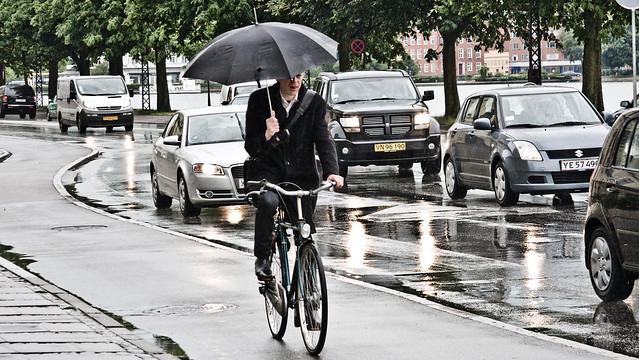 |
| Via Copenhagenize |
Supposedly we're almost done with Winter here in the Mid-Atlantic, although it would seem we've got a few chilly nights left to go. But now that we're seeing less and less snow, we're going to be seeing more and more rain, which is always extra-fun on a bicycle.
There are a lot of ways to deal with rain, ranging from high-tech rainsuits to "get wet and worry about it later." As shown in the image above, if you've got a relatively upright bike and a short distance to travel, simply riding slowly with an umbrella will do the job.
The major downside of umbrella-riding, other than wind, is that it only leaves you one hand on the handlebars. This is less of a problem in cities with civilized bicycle infrastructure, but here in the U.S., with our car-and-pedestrian obstacle courses, you might need both hands at once. There are a few designs out there that attach an umbrella to your bike for hands-free use, but I have never tried one, so I can't say if they work well at all.
For light rain and short trips, I often just use the same raincoat I would if I were walking around (your basic tan trenchcoat, usually), but over longer distances or in heavy rain, I find that even a trench coat doesn't cover my legs very well when pedaling, and the fronts of my thighs get wet (note, if you're using a full-length coat, make sure it's not dragging on the rear wheel. A lot of traditional city bikes have guards on the rear fender to prevent just such a problem).
For cold and wet days there are some great rain suits available, ranging from basic, rubbery PVC through space age breathable waterproof fabrics. The more breathable stuff is can cost several hundred dollars, but will keep you warm and dry at a moderate level of exertion. Most of these can be found in a roomy enough fit to wear over your regular clothes. The downside (aside from price) is that even the breathable stuff is pretty warm, and if the outside temperature is high enough you'll sweat and end up damp anyway (the high end stuff, when paired with high-tech moisture-wicking base layers can dissipate a lot of moisture, but if you're commuting in street clothes, you're out of luck).
Ponchos, whether store-bought or improvised from garbage bags, can work. They cover you pretty well from above, and when paired with fenders to keep off the spray from below, can be very effective. The disadvantage of a cheap poncho is that it flaps around a lot in the breeze, but if you can secure the front to your handlebars (I've tried it with rubber bands or clothespins and had some luck) you can get by OK. There are also cycling-specific ponchos, which feature elastic loops to hold the in place while you ride. I haven't tried one of these yet, but plan on getting one of the less expensive ones to use this spring, and I'll report back on how it works. They've been used successfully by commuters and tourists for a long time, though, so if you're not in a hurry (they're not aerodynamic at all), they'll probably work well.
The final approach, which is one I often use in warm weather, is to just resign yourself to getting wet. In the case of longer trips in particular, I simply pack a change of clothes in a waterproof bag and go. On a warm day, this can even be kind of fun. I'll usually wear synthetic clothes (maybe even swim trunks) that don't chafe when they get wet like cotton does, and usually a pair of Teva sandals. Even on a warmer spring day, wet cotton can also make you lose a lot of heat, so be aware of the temperature and go for synthetics or wool (Merino wool is machine washable and doesn't stink when wet) clothes.
If you go with that approach, though, I do recommend at least a rear fender. Rain water isn't very harmful, if you're warm enough, but the grit that comes up from the wet road surface can get between your and your saddle and... ouch.
No comments:
Post a Comment